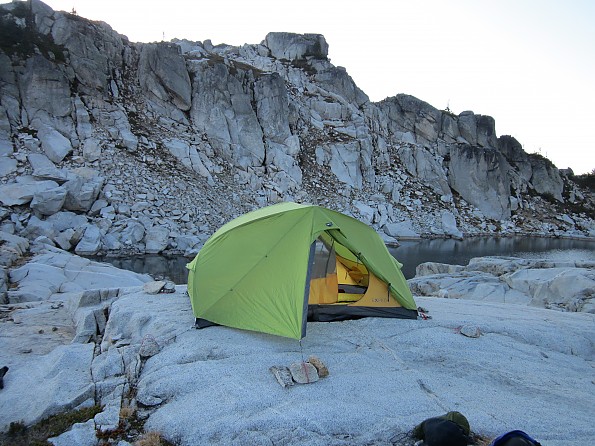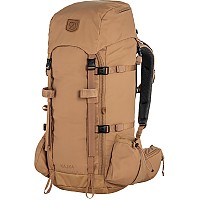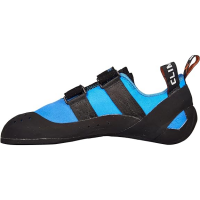Exped Gemini 2
The Gemini 2 has been discontinued. If you're looking for something new, check out the best three-season tents for 2025.

This tent provides awesome livability, a stable pole structure, and a fast setup. Exped put some time and effort into this tent and it shows.
Pros
- Easy and fast setup
- Strong pole structure
- Quality materials
- Great livability
Cons
- I can't think of any.
During my 4 days in the Maroon Bells Wilderness in Colorado, I unfortunately discovered my current tent was leaking through the seams on the fly. I can’t complain since the tent served me well for 7 years and lots of secure and dry night. When I got back home, I began looking for a new 2-person tent.
I looked at 2-person tents that weighed less than 4 pounds (that ended being so small on the inside that Clark Kent couldn’t change his mind) to 6 pound plus tents that I couldn’t justify carrying the extra weight. Throughout my tent buying adventure and the ensuing analysis paralysis, I seemed use the Exped Gemini 2 as my “compare against” tent and in the end, nothing else compared. I purchased one from Moontrail.com and had it sent to my house.
Exped is a company based in Switzerland and imports its products into North America through Exped LLC. I have long since been a fan of their sleeping bag mats and if you own one, you know they reek of quality. Before I pulled the trigger on purchasing this tent, I spent some time speaking with Brendan Collins from Exped LLC (North America) about how the tent was constructed and a few other details about Exped. He was very helpful and I would like to thank him for his time and efforts.
Inside the stuff sack, you will find the tent, fly, 4 poles, 8 stakes, repair kit and pole/stake/repair kit stuff sack. Here is the Exped claimed statistics directly from their website:
Gemini II
Capacity 2
Sizing
Floor space 220 x 125 cm 86.6 x 49.2"
Height inside 110 cm 43.3"
Canopy area 2.75 m² 29.6 sq ft
Vestibule area 2.0 m² 21.5 sq ft
Weight
Packed * 2.45 kg 5.3 lbs
Minimal ** 2.20 kg 4.8 lbs
Materials
Rainfly 30 D ripstop-nylon, silicone-PU coated, factory seam taped
Canopy UV-resistant, flame retardant ripstop polyester and No-See-Um netting
Floor 70 D PU-coated, taffeta nylon (5000 mm water column)
Poles 4 DAC Featherlight NSL 9 mm TH72M aircraft grade aluminium
Packed size 51 x 16 cm 20 x 6.3"
Setup time approx. 3 min
Color green
* Packed = All inclusive weight without packaging
** Minimal weight = Rainfly, canopy, poles
The claimed weight was 5lbs/5 oz’s and that’s exactly what I got right out of the box. Once I got rid of the rubber bands around the poles, repair kit packaging and all that sort of stuff, my tent weighed 5lbs/3 oz’s. The length, width and height dimensions claimed by Exped were also on the money.
One item of note is the overall height. While the peak interior height is 43" as claimed, I measured the maximum height of the pole structure at 46".
Setup of this tent is extremely simple and fast. I laid the tent out and inserted the 4 equal length poles into the sleeves. The sleeves are dead ended at each corner and this prevents you from walking around the tent to inserting a pole end into a grommet.
On each side of the tent just above the door, you will find a yellow, aluminum pole connector. This pole connector is the backbone of the pole structure. You take two poles, insert them into the pole connector, repeat on the other side and the tent setup is complete.
Here is a closeup of the pole connector.
You will find everything on this tent is color coded. The white toggle goes to the tent and the black toggle goes to the fly. One small detail I like about Exped’s design is the fact that it’s serviceable. Should something happen to the pole connector, it’s easily replaced by undoing the while hoop connector.
To this point, I spent about a one minute with the setup.
Once you stake out the tent, the fly gets connected to the pole connectors (one on each side) via the black toggle.
Connect the fly to the tent at each corner via the color coded clip toggle, stake it out and you’re finished.
I finished the set-up to this point in just over 2 minutes. Here is a YouTube link sponsored by Exped LLC Exped Gemini II Set-up - YouTube that shows the setup. It’s about 3-1/2 minutes long.
One important thing that drew me to this tent was the pole structure. My previous tent, and like many other tent designs, had 2 poles that crossed at the apex of the tent. While this arrangement does provide for a stable tent, the Gemini’s pole arrangement provides a significantly stronger structure. The 4 poles (or 2 continuous poles with the help of the connector) cross in 2 places rather than 1 and are at opposing ends of the tent. This arrangement, in conjunction with the continuous sleeves that evenly distribute any wind loads, provides an impressively stable structure.
Living in Colorado, I can see warmer nights in the upper 40’s to low 50’s, I can see downright nasty nights (I got caught in a freak blizzard on Longs Peak that dumped 6" of snow in JULY) and on rare occasions, I can see both in the same trip.
Another thing that drew me to this tent was the 4 ventilation holes. This tent has 2 lower vents at each end (where the guy lines exit from) and 2 higher ones at the top of the fly. In the following picture you can see 3 of the 4 with the other one on the opposite door. I couldn’t get a clear picture, but under the brow on the fly is a mesh panel. This panel is more than adequately covered by the brow to prevent water infiltration, but provides continuous air flow even with a fully zipped fly. Between all 4 vents, I have had zero issues with condensation.
The first time I set up this tent and climbed in, the word volume came to mind. The 43" peak height in conjunction with the vertical walls creates huge amounts of interior tent volume.
The interior of the tent has 6 stash pockets (1 at each corner and 2 in the overhead) that help with the equipment organization. The 2 in the over head are designed to hold the door when not needed, but at night, you could easily turn on your LED head lamp, stash it in the pocket and have overhead lighting.
Exped also added numerous red loops on the inside. According to their website, they don’t currently make a gear loft for this particular tent, but if a loft is your style, I’m sure you can buy a universal one and make it fit.
The guy lines on this tent are quite unique. There is only one other tent manufacturer that I can think of that connects the guy lines directly to the pole structure. Instead of connecting guy lines to the fly via a sewn loop, Exped added a stout webbed loop around the poles where they cross at each end of the tent.
The guy lines, when needed, are passed through the ventilation opening, staked out and tensioned. The guy lines are dyeema reflective cord and when not in use, the provided stuff sacks hold everything on the inside of the fly. Just to say I did, I weighed all the cords, tensioners and stuff sacks and everything came in at a whopping 0.6 oz’s (or 15 grams).
With my past tents, it seems like tent manufacturers assemble the fly, seam seal it, and then sew in the guy line/reflective loops. As I found out with my first North Face tent, the needle holes through the seam seal really do leak in prolonged storms. Exped on the other hand seam sealed the fly after it was fully assembled. This is one of the items that Brendan and I discussed in detail and will prevent me from seem sealing a brand new fly.
The vestibules on this tent are massive. As described on their website, the vestibules terminate 36" from the tent body. On the plus side, there is lots of space for gear storage when sleeping 2 in a tent and getting in/out isn’t a yoga pose. On the negative side, don’t expect to pitch this tent on a ridge line and get a tight fly. The overall dimension side to side is an honest 121".
This tent will easily sleep 2 people with all the gear stowed in the vestibules. I placed both my sleeping bag pads inside the tent and there was a little room to spare side to side. I hear many complaints from people that say the inside of a 2 person tent is really a 1-1/2 person tent. If this tent had severely sloped walls, I might agree. Since this tent has near vertical walls, I think Exped sized the floor perfectly.
Exped’s attention to detail extended to the stuff sacks. The first thing I noticed about the tent stuff sack was the lack of compression straps. I had a small concern the straps on my Osprey Kestrel 58 would be too short to allow me to secure it. On my first trip out, it turned out not to be an issue.
The second thing you notice about the tent stuff sack is the separate compartments for the tent body and the fly. You will find a nylon divider inside the sack to form the 2 compartments. Brendan had indicated the purpose for this was to minimize the water transfer from the fly to the tent if you were packing up after a rain storm. While this sounds good in theory, I found it to be a pain. The smaller opening made it that much more difficult to stuff the tent and fly into the sack. I’ll give it a few more tries, but I foresee removing the divider with some scissors.
Exped also provides a stuff sack for the tent poles, stakes and repair kit. The sack is all in one so you don’t have to keep track of a pole sack and a stake sack and a repair kit. The company was even kind enough to label it in three different languages.
The tent stakes provided by Exped were not some clunky bottom basement afterthought. The 8 stakes I received were top notch and weighted in at 3.1 oz’s (or 89 grams). With my past tents, the manufacturer didn’t provide enough stakes for all the anchor points and unfortunately, Exped continued that tradition. I counted 10 anchor points (4 on the tent body, 4 on the fly and 2 guy lines) and Exped only provided 8 stakes.
I will be more than happy to carry the extra 22 grams in order to fully stake out the tent when needed. If I had my say, I’d provide one extra stake as well. How many times have you dropped your tent in the early morning darkness and were unable to find that last tent stake you drove into the ground with a 10 pound rock the night before??
With several tents I’ve owned in the past, I’ve found it easy to cut some weight by using higher quality stakes and guy lines or remove other little items that I would never use. I have to admit, Exped beat me to the punch on all my usual suspects.
As I expected, the quality of this tent is outstanding. I diligently compared the listed dimensions and weights to the Exped specifications and I received exactly what the company said I would. I couldn’t find any variations in the materials, seam sealing or the construction of the tent body and fly.
In the mountains, this tent is a joy to live in. The internal volume was refreshing. The four ventilation brows allowed great airflow and I didn’t see any condensation on the fly or on the inside of the tent. My previous tent had a siliconized 20D floor and allowed me slide around when I was sleeping. The Gemini 2’s floor is poly urethane coated 70D and held me in place. That was a welcomed change. The large pockets easily stored the items I normally put away and the overhead pocket did work well with my headlamp.
If I was forced to say something negative, I would say Exped’s lack of tent distributors. I looked far and near to find a tent I could actually touch and never did. Exped claims they have distributers in Denver, but after calling the listed shops, they really don’t. I was a moderately uneasy about buying a tent over the internet sight unseen, but after speaking with Brendan about the tents construction, the other research I did and my past experience with Exped, I eventually worked through it and purchased one. Hopefully in the future, the company will expand their distribution.
Overall, I think Exped did an amazing job with this tent. It's remarkably light for everything it does, the livability is outstanding, the materials are high quality, and the little details separate this tent from many others.
Long Term Update 5/2016: Since I wrote this review, I've got an additional 30 days in the tent and it's just as amazing now as it was then. I've taken this tent across the floor of the Grand Canyon, through the Wind Rivers and numerous backpacking trips in Colorado. It continues to be an impressive piece of gear.
One note through and from my review above, I did end up removing the divider in the stuff sack. I think it is a great idea, but I didn't work for me. It might for someone else though. Enjoy.
Source: bought it new
Price Paid: $378
Basically, two thumbs up!
Pros
- Sturdy
- Good interior length
- Cheery colors
Cons
- Windy interior due to end air vents



My wife and I have used this tent for the last three years and like it a lot. It has a very sturdy structure, really taut and stable. We like how, if you unzip the inner tent door completely, it hangs from its apex (top) so there is no way it can fall to the ground...keeps the zippers out of harm's way!
The only thing we don't like is this: the end vents can't be closed. So, and here is the paradox, if it is windy and you want to use the end guy lines that pass through the end vents, you can't close the vents. And so the wind blows right onto your head (or feet) making for a windy (chilly) interior. So, the very feature that makes the tent extra stable in the wind (the guy lines that pass through the end vents) is also the same "feature" that lets the wind into the tent to a noticeable degree.
Besides that we love it. It has a good interior length, so there's plenty of room at your head or feet to stow some clothes. It is not exactly wide inside, but I wouldn't say it is super narrow either. But it is more generous length-wise than it is width-wise.
The side entry vestibules can keep your boots and pack out of the rain/snow. The fabrics Exped uses are bright and cheery—it is very pleasant being in the tent...a happy place to be, for sure! It is not super lightweight, but it is not heavy either...right around 4 1/2 Lbs. The floor is made of thick robust material, and the rest of the tent is also decent fabric..NOT super lightweight, but probably very durable.
The little bag for poles, repair kit and stakes is great! However, the stuff sack is not very useful (IMHO) except for storing the tent when not in use.
My wife and I split the tent into two roughly equal halves to carry in our packs, and each half is compact and lightweight.
The tent is easy to set up, easy to take down.
We bought some 6-mil black plastic sheeting at Home Depot and cut it to fit the tent as a footprint to help prolong the life of the tent floor.
We've camped in the rain, no problems.
We LOVE Exped. They make so much great gear. And, they have excellent customer service. They have gone beyond the call of duty with us more than once! Great tents, great sleeping pads, great pillows!
After discovering Exped, it is, quite frankly, difficult to even consider any of the major tent brands.
July, 2018 update:
One little irritation with the tent is that the rain fly can touch the mesh at one end of the tent. We have tried hard to pitch in in every way to try to avoid this, but, so far, there are times where we cannot prevent it. What this means is that if condensation collects on the inside of the rainfly, it can leak some drops sometimes into the inner tent through the mesh (when the rain fly and mesh are touching one another). We still love the tent though, and still have the tent, and still use the tent.
Source: bought it new
Price Paid: around $400 or so (give or take)
Your Review
You May Like
Specs
| Price |
Historic Range: $291.85-$489.00 Reviewers Paid: $378.00-$400.00 |


































